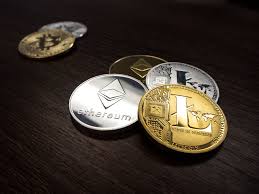What is an Altcoin?
Altcoin is a term used to describe every cryptocurrency other than Bitcoin. When Bitcoin was launched in 2009, it was the only cryptocurrency in existence. However, as blockchain technology advanced, developers started creating alternative digital currencies hence the name “altcoin” which stands for “alternative coin.” These coins were designed to fix Bitcoin’s limitations, add new features, or serve different purposes

Some altcoins focus on improving transaction speed, while others are created for privacy, decentralized finance (DeFi), or even entertainment, like meme coins. While Bitcoin remains the most recognized and dominant cryptocurrency, altcoins make up the majority of the crypto market, with thousands of them currently available.
Altcoins are not just “copies” of Bitcoin. Many bring innovation to the crypto world by introducing smart contracts, decentralized applications, and new consensus mechanisms. Ethereum, for example, transformed the blockchain space with its ability to run decentralized applications (DApps).
In simple terms, think of Bitcoin as the “first car ever invented,” while altcoins are all the newer models that came later—some faster, some cheaper, and some designed for luxury. Each altcoin has a purpose and offers something unique, which is why they play such an important role in the crypto ecosystem.
The Evolution of Altcoins
Altcoins have gone through significant transformations since the first one appeared. The earliest altcoins were designed to make small improvements to Bitcoin, such as reducing transaction time or offering lower fees. For example, Litecoin, launched in 2011, was one of the first altcoins that aimed to process transactions faster than Bitcoin.
As time went on, developers realized they could use blockchain for more than just peer-to-peer payments. This led to the rise of Ethereum in 2015, which introduced smart contracts a revolutionary feature allowing developers to build decentralized apps on the blockchain. This marked a major milestone in crypto history and gave birth to thousands of new altcoins that serve different industries.
Fast forward to today, and we have altcoins that support decentralized finance (DeFi), non-fungible tokens (NFTs), gaming, and even artificial intelligence projects. The altcoin market has matured significantly, with coins now being used in supply chain management, healthcare, and global remittance systems.
In other words, altcoins have evolved from being “Bitcoin alternatives” to becoming specialized tools for various industries. They are no longer just competing with Bitcoin but creating new ecosystems of their own.
Types of Altcoins
Not all altcoins are created equal. Each type serves a unique purpose, and understanding the categories helps investors decide which ones align with their goals.
Stablecoins
Stablecoins are designed to reduce volatility by pegging their value to stable assets like the US Dollar, Euro, or even gold. Examples include Tether (USDT) and USD Coin (USDC). They are widely used in trading because they allow investors to quickly move funds without exposure to extreme price swings.
Utility Tokens
Utility tokens are created to provide access to specific services or products within a blockchain ecosystem. For instance, Binance Coin (BNB) is used to pay transaction fees on the Binance exchange. These tokens often gain value as the platform they belong to becomes more popular.
Security Tokens
Security tokens represent ownership of real-world assets like stocks, bonds, or real estate. They are regulated and considered digital versions of traditional securities. This type of altcoin bridges the gap between traditional finance and blockchain.
Meme Coins
Meme coins like Dogecoin (DOGE) and Shiba Inu (SHIB) started as jokes but gained massive popularity due to community hype and celebrity endorsements. While they may not have strong use cases, their viral nature makes them interesting investments for risk-takers.
Privacy Coins
Privacy coins focus on making transactions untraceable and anonymous. Popular examples include Monero (XMR) and Zcash (ZEC). They are often controversial due to regulatory concerns but remain attractive for users who value financial privacy.
Altcoins are like tools in a toolbox each designed for a specific job. Knowing the differences helps investors make smarter decisions when building their portfolios.
Top Altcoins in the Market
With thousands of altcoins available, only a handful have established themselves as market leaders. These are the coins that consistently rank among the top in terms of market capitalization, adoption, and technology.
Ethereum (ETH)
Ethereum is the second-largest cryptocurrency after Bitcoin. It introduced smart contracts and decentralized applications (DApps), making it the foundation of DeFi and NFTs. The upcoming upgrades to Ethereum 2.0 focus on scalability and energy efficiency, ensuring it remains a key player in the crypto world.
Ripple (XRP)
Ripple is designed for fast, low-cost international money transfers. Unlike Bitcoin and Ethereum, Ripple works with banks and financial institutions to enable cross-border payments. Its partnerships with global banks make XRP one of the most practical altcoins for real-world use.
Litecoin (LTC)
Litecoin is often called the “silver to Bitcoin’s gold.” It was created to process transactions faster and at a lower cost than Bitcoin. Despite newer altcoins entering the market, Litecoin has remained relevant due to its simplicity and reliability.
Cardano (ADA)
Cardano is known for its scientific approach to blockchain development. It uses a proof-of-stake consensus mechanism, making it energy-efficient. Cardano aims to provide a platform for DApps, smart contracts, and financial inclusion in developing countries.
Solana (SOL)
Solana is one of the fastest blockchains, capable of handling thousands of transactions per second at very low costs. It has become a favorite for developers building DeFi platforms and NFT marketplaces. Despite some challenges, Solana continues to grow in adoption and ecosystem development.
These top altcoins represent the diversity and innovation in the crypto market. Each has its own strengths, making them attractive to different types of investors.
How Altcoins Work
At their core, altcoins function using blockchain technology, just like Bitcoin. However, each altcoin has its own way of processing transactions and maintaining network security.
Some altcoins use Proof of Work (PoW) like Bitcoin, where miners solve complex problems to validate transactions. Others use Proof of Stake (PoS), where users lock up their coins (staking) to help secure the network and earn rewards. PoS is considered more energy-efficient and scalable.
Different consensus mechanisms, like Delegated Proof of Stake (DPoS) or Proof of Authority (PoA), further diversify how altcoins operate. These mechanisms impact transaction speed, scalability, and energy usage.
Mining and staking are the two primary ways new altcoins are created and circulated. Mining requires hardware and electricity, while staking simply requires holding coins in a wallet. Both methods reward participants, ensuring the network remains active and secure.
In short, altcoins rely on blockchain technology but often experiment with different approaches to improve on Bitcoin’s design. This experimentation has led to a wide variety of coins with unique features and applications.


